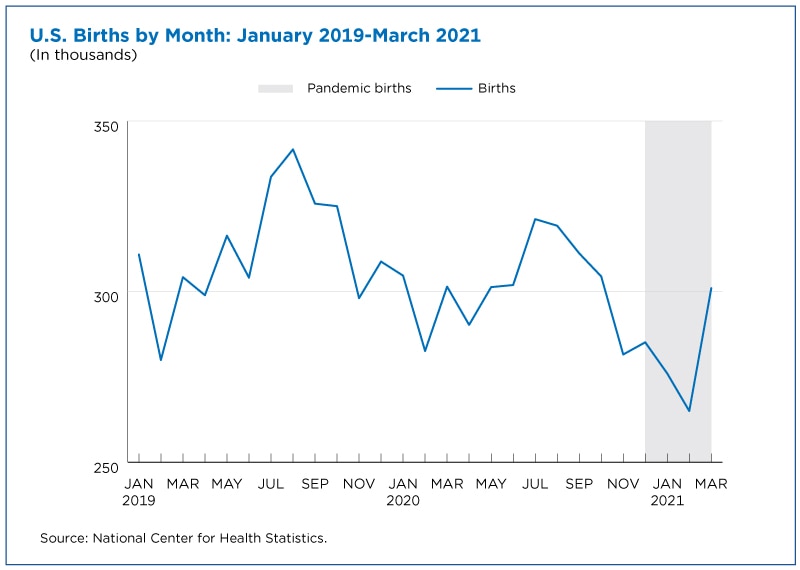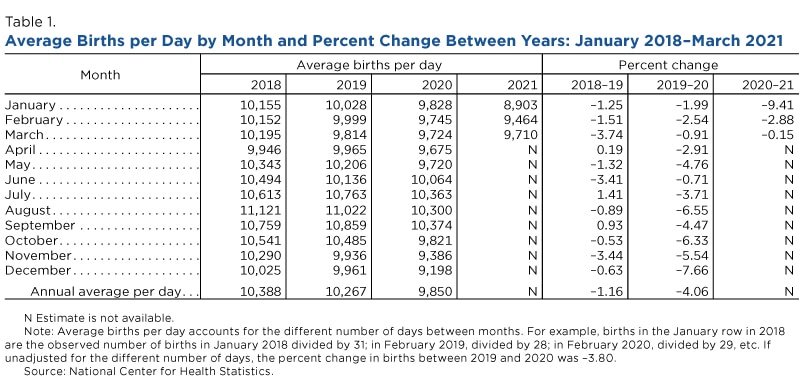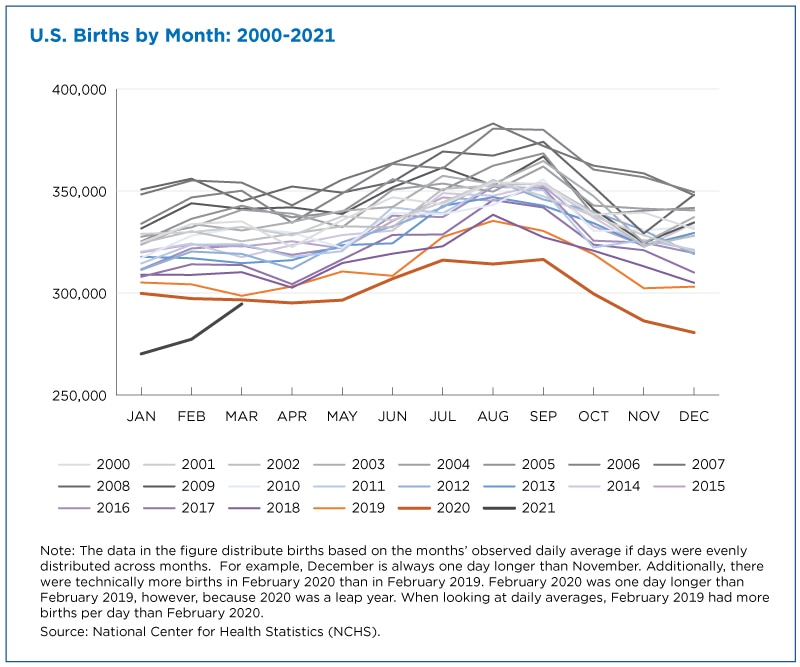
Last Updated on September 27, 2021 10:04 am
The COVID-19 pandemic has affected both the beginning and end of the life cycle for the U.S. population: Births declined and mortality went up.
Provisional monthly data show a downturn in births in winter 2020-2021 but there were signs of a possible rebound by March.
While the data indicate the pandemic caused the decline, we considered other factors, too.
Among them:
- Births in the United States have a seasonal pattern.
- The number of U.S. births has declined every year since 2008 (except for 2014).
- There are similar patterns in other countries.

COVID-19 was declared a national emergency March 13, 2020. The largest percentage of babies conceived after that would be born during or after the first week of December 2020. Evidence that the pandemic affected fertility can be seen starting in December 2020.
The Seasonal Effect
U.S. births have regular annual cycles: They normally increase in the spring, peak in the summer, decline in the fall and are lowest in the winter.
This means that, even in the absence of a pandemic, we would expect births to be lower in December and January than in the summer.
Even accounting for seasonality and the usual decline in annual births, the number of births in December 2020 and January 2021 was unusually low and that is very likely the result of the COVID-19 pandemic.
However, comparing one month during the pandemic to the same month before the pandemic shows a substantial drop that can’t be explained by seasonality.
There were 285,138 births in December 2020 — 23,664 (7.66%) fewer than in December 2019. On average, there were 763 fewer births each day in December 2020 than in December 2019.

U.S. Births Declining Since 2008
Not all of the decrease in births should necessarily be attributed to the pandemic. The number of U.S. births has been declining every year since 2008 (except 2014).
Between 2000 and 2019, the number of daily births declined an average 0.39% a year. The pace of decline accelerated between 2010 and 2019, when the number of daily births dropped on average 0.96% a year.
But the decline was much steeper in in 2020: The average number of daily births was 4.06% lower than in 2019.
Figure 2 shows births by year and month in the U.S. Even in the pre-pandemic months of 2020, there were fewer births each month than in 2019.
There was a noticeable decline in births especially in the summer. The summer decline suggests 2020 may have already been on track to experience a sharper decline in births than in previous years, even without the pandemic.
It is also possible that the pandemic led to a higher rate of conceptions not being carried to term.

Dip and Possible Rebound
Even accounting for seasonality and the usual decline in annual births, the number of births in December 2020 and January 2021 was unusually low and that is very likely the result of the COVID-19 pandemic.
As noted earlier, monthly data show a substantial decline in births (7.66%) in December of 2020 compared to December 2019. January births experienced an even greater year-to-year decline: down 9.41% from 2020 to 2021.
Births also declined in February 2021 compared to last year.
By March 2021, the decline slowed. Births declined only 0.15% between March 2020 and March 2021. This is substantially smaller than the 0.91% drop from March 2019 to March 2020.
This trend suggests that some people who postponed having babies last year had them this year.
The winter decrease in births may have been prompted by couples who consciously chose to delay having children amid the uncertainty of the pandemic. It may also have been influenced by stress or limited physical interaction with a sexual partner.
Other Countries
The United States is not alone in experiencing lower births followed by a slight rebound in the past year.
The Human Fertility Database shows monthly fertility data through December 2020 for 35 countries and through March 2021 for 30 countries. Although the database covers a limited number of countries, the pattern is clear.
Twenty-one of the 30 countries with monthly data through March 2021 had fewer births in December 2020 than in 2019 but more births in March 2021 than in March 2020.
Spain, for example, saw births decline in December 2020 but go back up in February and March. Spain also had more births in March 2021 than in March 2020. And Germany had more births in March 2021 than in any other March in the past 20 years.
It’s important to note that countries have different fertility and seasonality patterns. What’s more, countries experienced the brunt of the pandemic at different times and to different degrees.
Births and the Pandemic
It is still too soon to make broad conclusions about the pandemic’s effect on U.S. birth trends. But the data so far indicate there was a temporary drop in births amid the pandemic after accounting for other factors that existed before the pandemic — declining births and seasonality.
As time passes and more data become available, we will gain a better understanding of how the pandemic impacted fertility and will shape the size and composition of the nation’s population in the future.
Anne Morse is a demographer in the Census Bureau’s Estimates and Projections Area of the Population Division.



















